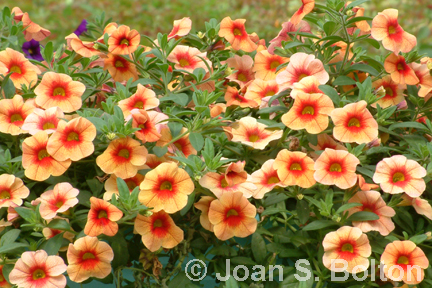
They’re here.
Springtime launches the debut of a new crop of brightly blooming perennials.
Visit any nursery now, and you’ll find row upon row of fresh, colorful beauties in 4-inch round or square pots.
Less expensive than a one-gallon plant and bearing a larger root mass than a seedling plucked from a pony pack, these 4-inchers are a perfect size to plant during the first days of spring.
In the garden, they’ll fill in quickly. Depending on what you choose, they’ll also bloom nonstop for as long as 12 to 24 months. However, it’s worth noting that while technically these prolific bloomers are perennials, because they expend so much energy to produce all those flowers, they may eventually collapse and never recover.
So at the end of however long their flowering might be, I give mine a good pruning. If they don’t respond within a few weeks, I yank them and start anew.
That said, the following short-lived perennials are among my favorites for quick, continuous color.
Summer Snapdragon (Angelonia)
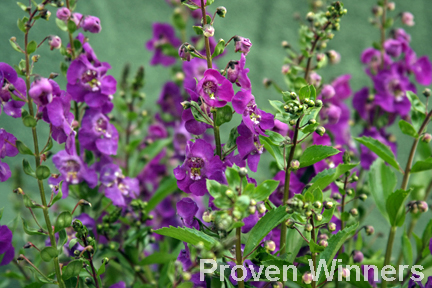
Picture a snapdragon for flower shape; a blue, pink, purple or white delphinium for flower color, and any kind of penstemon for slender, pointed leaves.
Combine those traits and you’ll have an Angelonia, which bears those plump flowers on upright spikes that grow 18 to 24 inches tall.
Angelonia blooms most heavily in heat, and prefers full sun and moderate to regular watering.
The plants are said to be deer resistant, although I haven’t tested them. The flowers are self-cleaning, meaning they’ll fall off neatly. Or harvest the spikes early and bring them indoors for a long-lasting bouquet.
Dresden Blue bears medium blue flowers and is among the most popular. Darker blues and darker purples are excellent as well.
Bidens
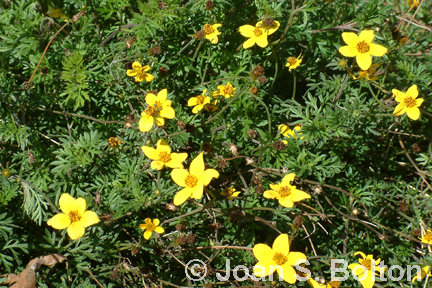
Bidens may look delicate, with its lush, ferny foliage and bright yellow daisy flowers. But this native of Mexico, Guatemala and the southern United States is surprisingly tough, blooming everywhere from cultivated gardens to more difficult conditions.
But provide full sun. My plants thrive in dry, clay soil and are nice, self-cleaning companions to lavender and Mexican sage.
Also check the plant tag for the growth habit. Some Bidens, such as Goldilocks Rocks, form neat mounds about a foot tall and wide, while others, such as Goldie, have a looser habit and trail 2 feet or more.
Swan River Daisy (Brachyscome)
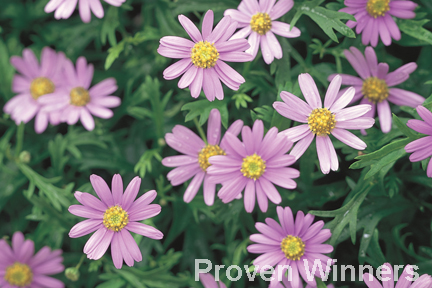
This fluffy perennial bears petite, daisy-like flowers in pastel shades of purple, pink, yellow or white, all with greenish-yellow centers.
Swan River daisy is a good filler between other plants, although it can be fussy about drainage, living longer in sandy soil than clay. I have grown mine next to a lawn, where its flexible stems and thready flowers have tolerated overspray from the sprinklers.
Provide full sun and regular water. Shear back the flowers occasionally to encourage more blooming.
Miniature Petunia or Million Bells (Calibrachoa)
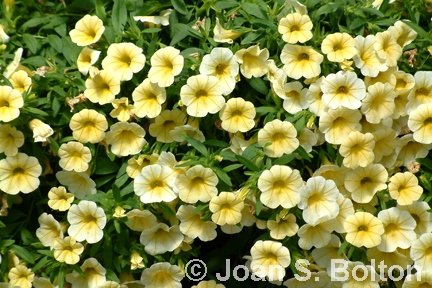
Is there a color this native of Brazil does not bloom in?
Perhaps because it’s such a popular and dependably prolific bloomer, hybridizers have spent much time on this spreading perennial, creating flowers in both pastel and bright shades of pink, rose, red, violet, orange, yellow and white.
The quarter-sized flowers look like small petunias. But the flowers drop off on their own, and the stems and leaves are not sticky. Some varieties grow flat, reaching only 6 inches tall, while others form clumpy mounds. Check to see which type you’re buying.
Provide full sun to light shade, good drainage and let the top inch of soil dry out between waterings.
Twinspur (Diascia)
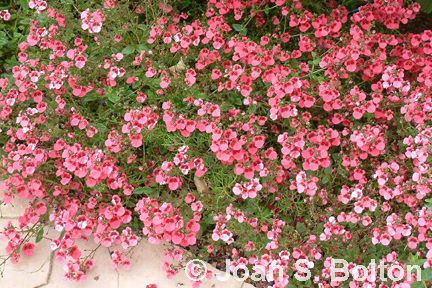
This offering from South Africa bears scores of pink, salmon, lavender or white flowers that open one after the next, up twisty, twirly stems. On the backsides of each flower are two curved “spurs” that are said to bear oil that attracts pollinating bees.
Trailing varieties of twinspur are good filler plants and spread at least 2 feet wide. Clumping types grow only a foot or so wide, and grouped together make nice masses of color. The plants are self-cleaning, so once again, no dead-heading is necessary.
Provide full sun to partial shade and moderate water. In the hottest inland areas, blooming may slow down or stop if night-time temperatures hover in the upper 70s or above. Go ahead and trim your plants if that happens. Doing so will encourage branching, which will produce even more flowers once the temps cool down.
Nemesia
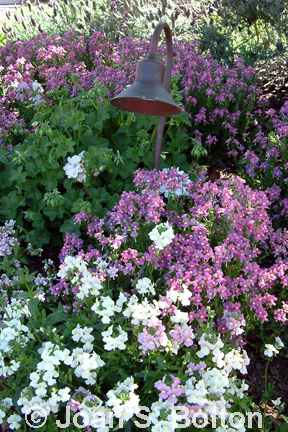
This South African native is fragrant, with a scent reminiscent of cloves. Upright spikes of flowers appear in purple, pink, blue, white and yellow.
Blue Bird is among the most widely planted, while varieties in the new Angelart series bloom in even more shades, with fruit names like pear, mango and raspberry.
Nemesia is best with full sun in the morning, then shade in the afternoon.
It also likes good drainage and regular water.
Like twinspur, it may stop blooming if night-time temperatures stay in the high 70s.
Again, snip back the foliage to promote more prolific blooming once the night-time temps drop.
Pincushion Flower (Scabiosa columbaria)
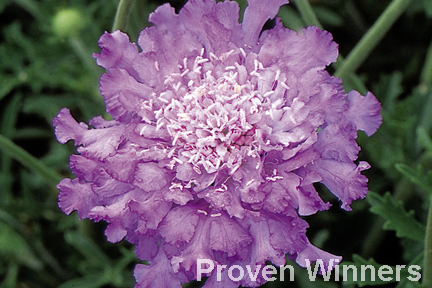
This short-lived perennial attracts butterflies with its pretty pink, lavender or blue flowers that look a little like flattened pompoms atop wiry stems. Individual stamens rise above the flowers, like straight pins stuck into sewing pincushions.
Provide full sun and moderate to regular water. In clay soil, pincushion flower may decline after a year or two; in sandy soil or loam, it should live longer.
This is one of the few 4-inchers that you’ll have to dead head. But doing so will encourage more ample flowering.
Fairy Fan Flower (Scaevola)
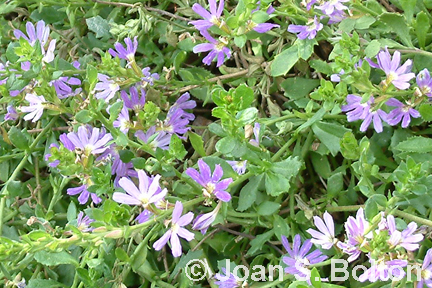
This native of Australia is longer lived than most, and forms a dense ground cover of unusual flowers that look only half formed, with nearly rectangular petals arranged like a fan.
Mauve Clusters is the flattest variety, growing only a few inches tall while trailing 3 feet wide. The Whirlwind and Top Pot series, in lavender, pink and white, bear larger flowers and grow up to 1 foot tall while spreading 3 feet wide.
Provide full sun and moderate to regular water. The flowers are self-cleaning.
Bacopa (Sutera)
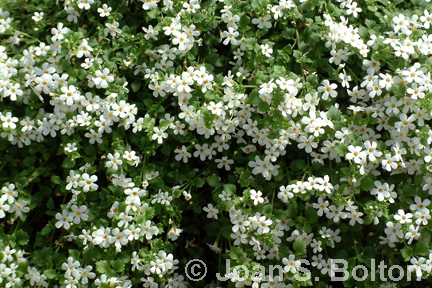
This popular perennial is widely planted in containers, with its tiny green leaves and bright white flowers spilling gracefully over the edges.
But bacopa does just as well in the ground, provided it receives full morning sun, afternoon shade and consistent, frequent watering. It is one of the thirstiest short-lived perennials. If yours starts dropping buds — even though the leaves are not wilting — it’s time to water.
Also provide enough room, as bacopa tends to roam far and wide. For instance, Giant Snowflake can spread 3 to 4 feet by the end of its first summer, while remaining only 6 to 8 inches tall.
The traditional white-on-green is my favorite. Newer varieties bloom in pink or lavender, and there’s even one called Gold ‘n Pearls, which bears variegated lime and green leaves.
Garden Verbena (Verbena x hybrida)
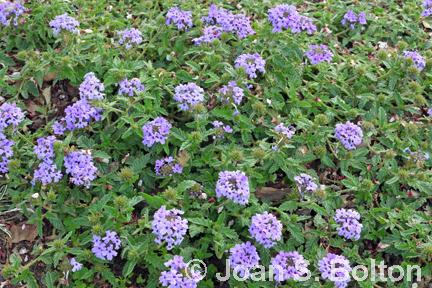
Rounded clusters of tiny flowers in purple, pink, red, white and nearly blue bloom on top of foot-tall plants that spread up to 3 feet wide. The little flower clusters make great landing pads for swallowtail butterflies to then sup the nectar.
Garden verbena is self-cleaning, tough and tolerates heat and marginal soils. It’s fine with moderate to regular water. But do not use overhead sprayers, which can cause mildew on the leaves and flowers.
≈
Planting Tips
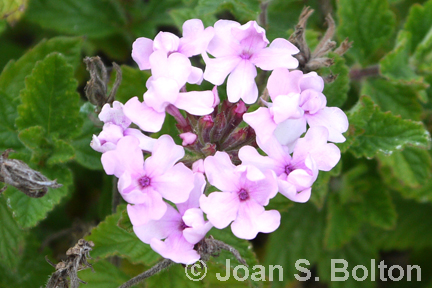
Your 4-inch perennials may be blooming heavily before their toes touch the ground.
In the garden, you’ll need to provide tip-top soil for most, to sustain the show.
Work in lots of well-rotted compost or other fine, organic material into the bed before planting. While the soil does not have to be as rich and loamy as for vegetables, it should still be fertile, loose and drain well.
For maximum impact, follow the spacing recommendations on the labels. For some short-lived perennials, that may be only a foot apart.
Some of these flashy bloomers tolerate overhead watering. But most will topple beneath the weight of waterlogged flowers or even mildew.
For best results, use soaker hose, drip irrigation or rim the area with a basin, then flood it whenever the top half inch to inch of soil dries out. A thick layer of mulch will stretch the time between watering.
≈
Seeds of Wisdom
Many showy, short-lived perennials bear dainty flowers that are best appreciated up close, planted as edgings along paths or patios, in masses or at the front of a border.
≈
Copyright, Joan S. Bolton. All rights reserved. Reproduction of text or photos in any form is prohibited without written permission.
≈
